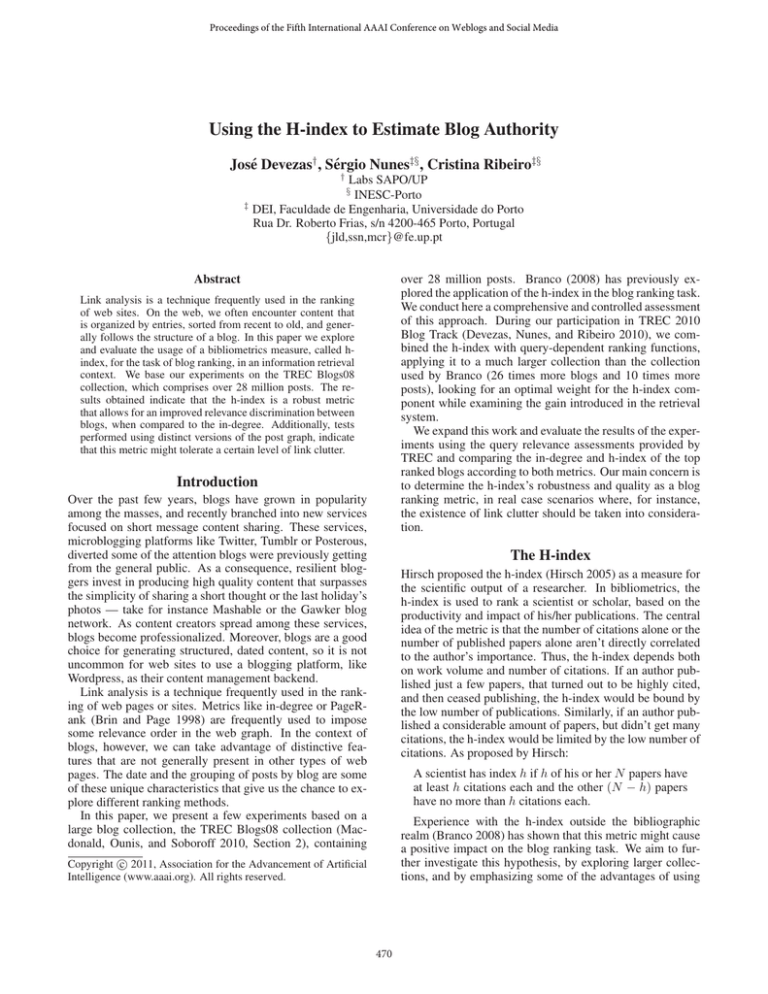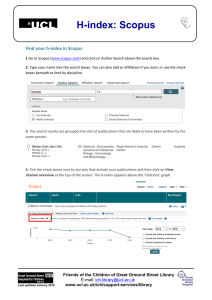
Proceedings of the Fifth International AAAI Conference on Weblogs and Social Media
Using the H-index to Estimate Blog Authority
José Devezas† , Sérgio Nunes‡§ , Cristina Ribeiro‡§
†
Labs SAPO/UP
INESC-Porto
DEI, Faculdade de Engenharia, Universidade do Porto
Rua Dr. Roberto Frias, s/n 4200-465 Porto, Portugal
{jld,ssn,mcr}@fe.up.pt
§
‡
over 28 million posts. Branco (2008) has previously explored the application of the h-index in the blog ranking task.
We conduct here a comprehensive and controlled assessment
of this approach. During our participation in TREC 2010
Blog Track (Devezas, Nunes, and Ribeiro 2010), we combined the h-index with query-dependent ranking functions,
applying it to a much larger collection than the collection
used by Branco (26 times more blogs and 10 times more
posts), looking for an optimal weight for the h-index component while examining the gain introduced in the retrieval
system.
We expand this work and evaluate the results of the experiments using the query relevance assessments provided by
TREC and comparing the in-degree and h-index of the top
ranked blogs according to both metrics. Our main concern is
to determine the h-index’s robustness and quality as a blog
ranking metric, in real case scenarios where, for instance,
the existence of link clutter should be taken into consideration.
Abstract
Link analysis is a technique frequently used in the ranking
of web sites. On the web, we often encounter content that
is organized by entries, sorted from recent to old, and generally follows the structure of a blog. In this paper we explore
and evaluate the usage of a bibliometrics measure, called hindex, for the task of blog ranking, in an information retrieval
context. We base our experiments on the TREC Blogs08
collection, which comprises over 28 million posts. The results obtained indicate that the h-index is a robust metric
that allows for an improved relevance discrimination between
blogs, when compared to the in-degree. Additionally, tests
performed using distinct versions of the post graph, indicate
that this metric might tolerate a certain level of link clutter.
Introduction
Over the past few years, blogs have grown in popularity
among the masses, and recently branched into new services
focused on short message content sharing. These services,
microblogging platforms like Twitter, Tumblr or Posterous,
diverted some of the attention blogs were previously getting
from the general public. As a consequence, resilient bloggers invest in producing high quality content that surpasses
the simplicity of sharing a short thought or the last holiday’s
photos — take for instance Mashable or the Gawker blog
network. As content creators spread among these services,
blogs become professionalized. Moreover, blogs are a good
choice for generating structured, dated content, so it is not
uncommon for web sites to use a blogging platform, like
Wordpress, as their content management backend.
Link analysis is a technique frequently used in the ranking of web pages or sites. Metrics like in-degree or PageRank (Brin and Page 1998) are frequently used to impose
some relevance order in the web graph. In the context of
blogs, however, we can take advantage of distinctive features that are not generally present in other types of web
pages. The date and the grouping of posts by blog are some
of these unique characteristics that give us the chance to explore different ranking methods.
In this paper, we present a few experiments based on a
large blog collection, the TREC Blogs08 collection (Macdonald, Ounis, and Soboroff 2010, Section 2), containing
The H-index
Hirsch proposed the h-index (Hirsch 2005) as a measure for
the scientific output of a researcher. In bibliometrics, the
h-index is used to rank a scientist or scholar, based on the
productivity and impact of his/her publications. The central
idea of the metric is that the number of citations alone or the
number of published papers alone aren’t directly correlated
to the author’s importance. Thus, the h-index depends both
on work volume and number of citations. If an author published just a few papers, that turned out to be highly cited,
and then ceased publishing, the h-index would be bound by
the low number of publications. Similarly, if an author published a considerable amount of papers, but didn’t get many
citations, the h-index would be limited by the low number of
citations. As proposed by Hirsch:
A scientist has index h if h of his or her N papers have
at least h citations each and the other (N − h) papers
have no more than h citations each.
Experience with the h-index outside the bibliographic
realm (Branco 2008) has shown that this metric might cause
a positive impact on the blog ranking task. We aim to further investigate this hypothesis, by exploring larger collections, and by emphasizing some of the advantages of using
c 2011, Association for the Advancement of Artificial
Copyright Intelligence (www.aaai.org). All rights reserved.
470
Post
In-degree
1
16
2
16
3
6
4
3
5
1
Table 1: Example of a post in-degree list.
the h-index in real blog networks.
Blog Ranking
There are several methods for blog ranking, ranging from
the simplicity of the in-degree to the specificity of the
iRank (Adar, Zhang, and Adamic 2004), a metric that takes
into consideration the importance of blogs in the propagation of information.
A connection between blogs and scientific authorship can
easily be established. A blog is comparable to an author
or scholar, while its posts are analogous to papers. In resemblance to bibliometry, a blog’s relevance should be measured by taking into account both the number of in-links and
the number of published entries, thus taking advantage of
the grouping of posts by blog, together with their individual
number of in-links, in order to more efficiently rank blogs.
Hence, we hypothesize that the h-index might be a strong
ranking metric while requiring a relatively small processing
power to compute. From the definition of h-index:
(a) H-index distribution.
(b) In-degree distribution.
Figure 1: The TREC Blogs08 Collection.
Experimentation
We conduct some experiments based on the TREC Blogs08
collection, using the in-degree as baseline to assess the quality of the h-index on the blog ranking task. We analyze both
distributions, comparing the in-degree and the h-index, for
the top ranked blogs according to both metrics. We then
explore the influence of link clutter while combining these
link-based metrics, as a query-independent feature, with the
BM25 score, in an information retrieval context.
TREC Blogs08 Collection
A blog has index h if h of its N posts have at least h
in-links each and the other (N − h) posts have no more
than h in-links each.
The TREC Blogs08 collection is a compilation of over 1.3
million blogs, comprising more than 28 million posts, with a
total compressed size of 453 GB. The files are formatted in a
way that can easily be indexed by the Terrier platform (Ounis et al. 2006). By using this platform and by taking advantage of the query relevance assessments that TREC provides,
we are able to explore the influence of the h-index in the
blog distillation task. We want to know whether we can improve the blog retrieval process by combining the h-index,
a query-independent feature, with query-dependent scores,
such as the BM25 score. We carry on this line of work, by
exploring the application of the h-index in the same task,
now by calculating it based on three different versions of the
post graph. The first version of the graph corresponds to
the full graph we used for TREC, which includes post selfcitations and link multiplicity. The second graph is identical
to the full graph without self-citations or loops. And finally,
for the third graph, we apply another layer of cleaning, by
removing both loops and link or edge multiplicity.
Calculating the H-index of a Blog
We determine the h-index of a blog based on the in-degree of
its posts. Algorithm 1 illustrates the simple steps taken for
the calculation of the h-index. Given a list with the number
of in-links for each post, we sort it and reverse it. Then, we
increment the value of h until the in-degree is larger than h
or we reach the end of the list.
Table 1 shows an example of a blog with 5 posts, each
with a given number of in-links. According to the h-index
definition, the value of h is 3, as there are 3 posts with at
least 3 in-links each and the other 2 posts have no more than
3 in-links. To clarify, if we assumed h = 2, we would find
that one of the other 3 posts has more than 2 in-links, which
violates the definition. On the other hand, if we to assumed
h = 4, we wouldn’t find 4 posts with at least 4 in-links, since
the post at rank 4 has 3 in-links.
Data Extraction
In order to compute the h-index, we first need a post indegree list for each blog. To calculate these values, we follow some simple steps. First, we parse each post, extracting
every URL found on the href attribute of the HTML anchors
in the entries. Next, we remove the URLs whose domains
don’t belong to the blog collection, and reverse the representation of the graph. This results in a text file containing a
list of posts associated with their respective in-links. Sorting
this file allows us to easily group the posts by blog, count
the number of in-links of each post, and calculate the blog’s
h-index.
Algorithm 1 Blog’s h-index calculation.
Input: List L of post in-degrees for a blog.
Output: H-index of the blog.
L ← sort(L)
L ← reverse(L)
h←0
while Lh > h do
h←h+1
end while
471
Legend
Legend
H−index
In−degree
106
H−index
In−degree
106
105
105
104
104
103
103
102
102
101
101
100
100
1 2 3 4 5 6 7 8 9 10 11 12 13 14 15 16 17 18 19 20 21 22 23 24 25
Rank
1 2 3 4 5 6 7 8 9 10 11 12 13 14 15 16 17 18 19 20 21 22 23 24 25
Rank
(a) Top 25 blogs according to the h-index.
(b) Top 25 blogs according to the in-degree.
Figure 2: Comparison between the h-index and the in-degree as blog ranking metrics, in the full Blogs08 post graph.
Rank
1
2
3
4
5
Domain
www.delightfulblogs.com
masalog.com
taurinerules.blogspot.com
blogs.nypost.com (TV)
blogs.nypost.com (Sports)
H-index
700
603
511
511
473
In-degree
2,639,287
604,239
289,159
439,516
335,407
0.9
0.8
0.7
Rank
1
2
3
4
5
Domain
bodyelectric.blogspot.com
rpc.blogrolling.com
www.delightfulblogs.com
richard-upton.blogspot.com
feeds.feedburner.com
In-degree
5,345,032
5,025,547
2,639,287
1,921,344
1,242,343
ρ
Table 2: Top 5 blogs ranked by h-index according to the full
Blogs08 post graph blog.
0.6
0.5
H-index
2
301
700
11
24
0.4
1e+05
2e+05
3e+05
Top
4e+05
5e+05
6e+05
Figure 3: Spearman’s correlation coefficient.
Table 3: Top 5 blogs ranked by in-degree according to the
full Blogs08 post graph.
in bodyelectric.blogspot.com with 2 or more in-links from
other blogs in the collection. This illustrates one of the
strengths of the h-index when compared with the in-degree,
in the blog ranking task, the ability to account for the number of posts in a blog.
We rank blogs according to their in-degree and h-index,
and calculate Spearman’s rank correlation coefficient (BarIlan 2005) for the top k blogs, where k ranges from 25 to
1000, in steps of 25, and then from 1000 to 659,452 (the total
number of blogs with at least one in-link or one out-link), in
steps of 5000. Figure 3 depicts the evolution of Spearman’s
ρ for a progression of cuts of the in-degree and h-index rank
lists. The value of ρ is constantly smaller than 0.76, for cuts
bellow 20,000, even dropping to 0.33 for the top 50 cut. For
cuts above 20,000, ρ tends to grow and stabilize around 0.99.
The 0.76 rank correlation for the highest ranked results
led us to further explore the quality of the h-index in the blog
distillation task. We use the TREC Blogs08 collection, that
we had previously indexed using the Terrier platform, and
Data Analysis
Figure 1 depicts the in-degree and h-index distributions for
the TREC Blogs08 collection. Values for the in-degree are
highly diverse, ranging from 0 to 5,345,032, with 15,309
distinct values. On the other hand, there are only 205 distinct h-index values, ranging from 0 to 700 — the h-index
is bound by the number of posts in a blog. Figure 2 depicts the values of both the in-degree and the h-index, for
the top 25 blogs, according to (a) the h-index and (b) the
in-degree. Looking at Figure 2(a), we verify that, even
though the in-degree doesn’t follow the same behavior as
the h-index, blogs with a high h-index also have a high indegree — Table 2 illustrates some of these values. On the
other hand, Figure 2(b) depicts a different scenario, where
we can find extremely low h-index values for some of the
highest in-degree scores. By looking at Table 3, we can
see that the h-index for the highest ranked blog according
to the in-degree is 2, meaning that there are only 2 posts
472
0.185
0.185
0.185
0.180
0.180
0.180
0.175
MAP
0.190
MAP
0.190
MAP
0.190
0.175
0.170
0.175
0.170
Metric
0
10
0.170
Metric
H−Index
In−Degree
Metric
H−Index
In−Degree
20
w
30
40
(a) Full Blogs08 post graph.
50
0
10
H−Index
In−Degree
20
w
30
40
50
(b) Blogs08 post graph without loops.
0
10
20
w
30
40
50
(c) Blogs08 post graph without loops and
edge multiplicity.
Figure 4: MAP for the combined BM25 score and link-based metric, in the TREC Blogs08 Collection.
Acknowledgements
base our explorative work on the query topics and relevant
assessments provided for TREC 2010. We determine the
values for the link-based metrics — the query-independent
features of our system — based on the three different versions of the post graph previously described. We then include the h-index and the in-degree in the final score, by
adding w × log(metric) to the BM25 score, where metric
is either the h-index or in-degree value. Equation 1 shows
how to calculate the score for a query q and a blog b based
on the h-index metric:
score(q, b) = BM 25(q, b) + w ∗ log(h-index(b))
We thank Filipe Coelho for all the fruitful discussions.
This work was partially supported by a research grant from
Labs SAPO/UP.
References
Adar, E.; Zhang, L.; and Adamic, L. 2004. Implicit structure and the dynamics of blogspace. In Workshop on the
Weblogging Ecosystem.
Bar-Ilan, J. 2005. Comparing rankings of search results on the Web. Information Processing & Management
41(6):1511–1519.
Branco, J. 2008. Aplicação do h-index em blogues. Master’s
thesis, Faculty of Engineering, University of Porto.
Brin, S., and Page, L. 1998. The anatomy of a large-scale
hypertextual web search engine. Computer Networks and
ISDN Systems.
Devezas, J. L.; Nunes, S.; and Ribeiro, C. 2010. FEUP
at TREC 2010 Blog Track: Using h-index for blog ranking.
In The Nineteenth Text REtrieval Conference Proceedings
(TREC 2010).
Hirsch, J. 2005. An index to quantify an individual’s scientific research output. Proceedings of the National Academy
of Sciences of the USA 102(46):16569–16572.
Macdonald, C.; Ounis, I.; and Soboroff, I. 2010. Overview
of the TREC 2009 Blog track. In The Eighteenth Text REtrieval Conference Proceedings (TREC 2009).
Ounis, I.; Amati, G.; Plachouras, V.; He, B.; and Macdonald, C. 2006. Terrier: A high performance and scalable information retrieval platform. Proceedings of ACM
SIGIR’06 Workshop on Open Source Information Retrieval
(OSIR 2006).
(1)
Figure 4 depicts the evolution of the mean average precision (MAP) across the one hundred TREC topics, as we
increase w, the weight of the in-degree or h-index in the final score. As we remove link clutter, we notice that the MAP
values for the results based on the in-degree metric tend to
improve in the absence of graph loops and edge multiplicity.
On the other hand, MAP values for the results based on the
h-index are very similar for (a) and (b), indicating that the
removal of graph loops has only a light influence on the results. By removing edge multiplicity (c), the values of MAP
actually decrease, indicating that edge multiplicity is relevant to the computation of the h-index for the blog ranking
task.
Conclusions
We have ranked blogs according to two distinct metrics,
the in-degree and the h-index, while studying their behavior when affected by different levels of link clutter. We applied these metrics to an information retrieval context by using them as query-independent features, and evaluated their
quality based on the relevance assessments for the query
results we obtained. Using the h-index metric we were
able to consistently improve the quality of the results over
the BM25 baseline, for three different versions of the post
graph. The boundaries imposed by the h-index, regarding
the number of posts and in-links, allow this metric to establish a more balanced measurement of blog relevance than
the in-degree metric, specially improving the ranking of the
top blogs.
473




